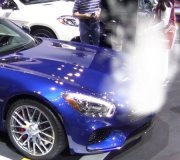First, we have to figure out if the engine is getting too hot or if the cooling system just isn't carrying the heat away. Dash gauges are notoriously inaccurate and should only be used by the driver to notice when something unusual is occurring. It is far more accurate to use a scanner to look at the live data the Engine Computer is seeing. It uses a different coolant temperature sensor that must be more accurate. What are your observations that are telling you the engine is overheating?
Rebuilding an engine won't address an overheating problem except for a leaking cylinder head gasket. That is replaced without rebuilding the complete engine. You might want to start with a "leak sniffer" test at the radiator. Here's a link to an article showing how that is done:
https://www.2carpros.com/articles/head-gasket-blown-test
You can usually borrow this tester from an auto parts store that rents or borrows tools, but beware, they will usually make you buy your own bottle of fluid. That's because it is rendered ineffective if it freezes or becomes contaminated with antifreeze. They don't want to risk borrowing it to the next person with contaminated fluid.
This test determines if combustion gases are sneaking into the cooling system through a leaking head gasket. When that happens, the gas can pool under the thermostat causing it to not open. Thermostats have to be hit with hot liquid to open. Hot air won't do it. That caused the engine to get too hot.
No normal engine needs four fans to cool it. When that isn't enough, it suggests the heat is not leaving the radiator. There are a lot of potential causes for that, especially on heavily-modified vehicles. The biggest offender is when the radiator shroud is removed. Those are needed to force the fan to pull cool air through the radiator, not around it. Removing the shroud allows any air that has gone through the radiator to circulate back out the front from under-hood air pressure and go back through the radiator again. That air keeps getting hotter and hotter until it isn't doing anything.
Along with this, look for holes in the core support and look for missing rubber seals. On the cars I used to race, (Challengers, Darts, and Barracudas), removing the unneeded charcoal canister, for example, opened up a hole in the core support for air to bypass the radiator. Those need to be sealed with a piece of tin. When you have transmission cooling lines or AC lines that pass through the core support, you'll usually find foam seals around those hoses to prevent air from sneaking through. Any other holes in the core support should be sealed or covered.
There will be a rubber seal usually under the front edge of the hood, from the left to the right side, or sometimes on top of the core support. It has an important job of sealing that gap so air can't go over the radiator. Removing that seal can be just as detrimental as not having the shroud in place.
Your radiator is new enough, but for others researching this topic, especially those of us in states where they throw a pound of salt on an ounce of snow, corroded cooling fins are a common problem. When they crumble like a rotten chocolate chip cookie when you touch them, they are no longer effective at pulling heat from the coolant. This is where the engine will run hotter on hot days and when you drive at highway speeds. When the fan is the problem, the engine runs cooler at highway speeds where natural air flow does the work.
Original radiators are adequate for the vehicle they were designed for, but often with little extra. You'll see them referred to as "two-core" or "three-core" for the number of rows of cooling tubes, front to rear. A vehicle could have needed a three-core radiator and would have come with that from the manufacturer, but a similar model may have only needed a two-core. Since both are available as replacements and both fit in the same opening, it is possible to install a replacement that doesn't have the cooling capacity needed. Also, if any modifications are done that result in more fuel being used and more heat generated, it may be necessary to upgrade to the three-core radiator. That would be much more effective than adding another fan.
Here's more information from the Cherokee service manual.
Images (Click to make bigger)
Sunday, April 17th, 2022 AT 2:27 PM








